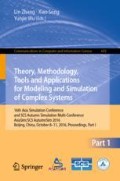Abstract
This paper proposes a new method to recognize airborne phased array radar (AESA) under different modes, based on multi-level modeling combined with Adaptive Stacked Denoising Autoencoder. In order to analyze the change law of pulses intercepted by intelligence, multi-level modeling is proposed to model the pulses at pulse level, pulse group level and work mode level. Then adaptive stacked denoising auto-encoder is trained to extract amplitude characteristics at the work mode level. Finally Softmax classification is added to the top of deep network to realize work mode recognition of airborne phased array radar. Qualitative experiments show that compared with the original algorithm based on knowledge base, the new method is able to extract essential characteristics of the input, reduce the dependence on prior knowledge, and achieves good performance.
References
Farina, A., Holbourn, P., Kinghorn, T., Timmoneri, L.: AESA radar-pan-domain multi-function capabilities for future systems. In: 2013 IEEE International Symposium on Phased Array Systems & Technology, Boston, October 2013
Hommel, H., Feldle, H.-P.: Current status of airborne active phased array (AESA) radar systems and future trends. In: Proceedings of 34th European Microwave Conference, October 2004, vol. 3, pp. 1517–1520 (2004)
Jia, C.-W., Zhou, S.-L.: Work mode identification of airborne radar. Electron. Inf. Warfare Technol. 26(1), 14–16 (2011)
Visnevski, N., Krishnamurthy, V., Wang, A., Haykin, S.: Syntactic modeling and signal processing of multifunction radars: a stochastic context-free grammar approach. Proc. IEEE 95(5), 1000–1025 (2007)
Liu, H.D., Yu, H., Sun, Z., et al.: Multi-function radar emitter identification based on stochastic syntax-directed translation schema. Chin. J. Aeronaut. 27(6), 1505–1512 (2014)
Hinton, G.E., Osindero, S., Whye Teh, Y.: A fast learning algorithm for deep belief nets. Neural Comput. 18, 1527–1554 (2006)
Le, Q.V., Ngiam, J., Coates, A., et al.: On optimization methods for deep learning. In: International Conference on Machine Learning, pp. 265–272 (2011)
Vincent, P., Larochelle, H., Lajoie, I., et al.: Stacked denoising auto-encoders: learning useful representations in a deep network with a local denoising criterion. J. Mach. Learn. Res. 11, 3371–3408 (2010)
Vincent, P., Larochelle, H., Bengio, Y., et al.: Extracting and composing robust features with denoising auto-encoders. In: Proceedings of the 25th International Conference on Machine Learning (2008)
Chandra, B., Sharma, R.K.: Adaptive noise schedule for denoising autoencoder. In: Loo, C.K., Yap, K.S., Wong, K.W., Teoh, A., Huang, K. (eds.) ICONIP 2014, Part I. LNCS, vol. 8834, pp. 535–542. Springer, Heidelberg (2014)
Author information
Authors and Affiliations
Corresponding author
Editor information
Editors and Affiliations
Rights and permissions
Copyright information
© 2016 Springer Science+Business Media Singapore
About this paper
Cite this paper
Li, H., Jin, W., Liu, H., Zheng, K. (2016). Adaptive Stacked Denoising Autoencoder for Work Mode Identification of Airborne Active Phased Array Radar. In: Zhang, L., Song, X., Wu, Y. (eds) Theory, Methodology, Tools and Applications for Modeling and Simulation of Complex Systems. AsiaSim SCS AutumnSim 2016 2016. Communications in Computer and Information Science, vol 643. Springer, Singapore. https://doi.org/10.1007/978-981-10-2663-8_24
Download citation
DOI: https://doi.org/10.1007/978-981-10-2663-8_24
Published:
Publisher Name: Springer, Singapore
Print ISBN: 978-981-10-2662-1
Online ISBN: 978-981-10-2663-8
eBook Packages: Computer ScienceComputer Science (R0)

